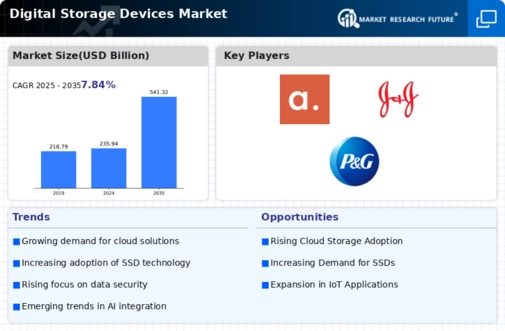Rising Data Generation
The exponential increase in data generation across various sectors appears to be a primary driver of the Global Digital Storage Devices Market Industry. As organizations and individuals create and consume vast amounts of data, the demand for efficient storage solutions intensifies. In 2024, the market is valued at approximately 235.94 USD Billion, reflecting the urgent need for scalable storage options. This trend is particularly evident in industries such as healthcare, finance, and entertainment, where data-driven decision-making is crucial. Consequently, the Global Digital Storage Devices Market Industry is likely to witness sustained growth as businesses seek to manage and store their data effectively.
Market Growth Projections
The Global Digital Storage Devices Market Industry is projected to experience substantial growth over the next decade. With a market valuation of approximately 235.94 USD Billion in 2024, it is anticipated to reach 541.32 USD Billion by 2035. This remarkable growth trajectory suggests a compound annual growth rate of 7.84% from 2025 to 2035. Factors contributing to this growth include technological advancements, increased data generation, and the rising adoption of cloud services. As the demand for efficient and scalable storage solutions continues to rise, the market is likely to evolve, presenting new opportunities for innovation and investment.
Technological Advancements
Technological innovations in storage solutions significantly influence the Global Digital Storage Devices Market Industry. The advent of solid-state drives (SSDs), cloud storage, and advanced data management systems has transformed how data is stored and accessed. These advancements not only enhance performance but also reduce costs, making storage solutions more accessible to a broader audience. As of 2024, the market continues to evolve, with projections indicating a robust growth trajectory. By 2035, the market is expected to reach 541.32 USD Billion, suggesting that ongoing technological developments will play a pivotal role in shaping the future of data storage.
Surge in Consumer Electronics
The proliferation of consumer electronics, such as smartphones, tablets, and laptops, is a notable driver of the Global Digital Storage Devices Market Industry. As consumers increasingly rely on these devices for personal and professional use, the demand for high-capacity storage solutions escalates. In 2024, the market is projected to be valued at 235.94 USD Billion, reflecting the growing need for portable and efficient storage options. Furthermore, the trend towards high-definition content consumption necessitates larger storage capacities, further fueling market growth. This consumer-driven demand is likely to shape the landscape of digital storage devices in the coming years.
Emerging Markets and Economic Growth
Emerging markets are becoming increasingly influential in the Global Digital Storage Devices Market Industry. As economies in regions such as Asia-Pacific and Latin America continue to grow, there is a rising demand for digital storage solutions across various sectors. This growth is driven by urbanization, increased internet penetration, and the expansion of digital services. The market is expected to experience a compound annual growth rate of 7.84% from 2025 to 2035, indicating that these regions will play a crucial role in the overall expansion of the industry. As businesses and consumers in emerging markets seek advanced storage solutions, the Global Digital Storage Devices Market Industry is poised for significant growth.
Increased Adoption of Cloud Services
The growing reliance on cloud computing services is a significant factor propelling the Global Digital Storage Devices Market Industry. Organizations are increasingly migrating to cloud-based solutions to enhance flexibility, scalability, and collaboration. This shift is driven by the need for remote access to data and the ability to store large volumes of information without the constraints of physical hardware. As cloud storage becomes more prevalent, the demand for associated digital storage devices is likely to rise. The market's growth is expected to maintain a compound annual growth rate of 7.84% from 2025 to 2035, indicating a strong correlation between cloud adoption and storage device demand.













